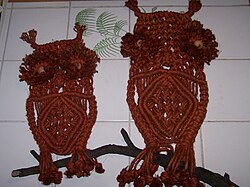AY Honors/Macramé/Answer Key
Macramé or macrame is a form of textile-making using knotting rather than weaving or knitting. Its primary knots are the square knot and forms of hitching (full hitch and double half hitches). It has been used by sailors, especially in elaborate or ornamental knotting forms to decorate anything from knife handles to bottles to parts of ships. Macrame is viewed as a more masculine formTemplate:Fact of craft comparative to traditional knitting techniques, as evident in ancient Nordic tradition.
Cavandoli macrame is a variety of macrame that is able to form geometric patterns and/or free-form patterns like weaving. The Cavandoli style is done mainly in a single knot, the double half hitch knot.
Common materials used in macrame include cotton twine, hemp, leather or yarn. Jewelry is often made in combination of both the knots and various beads (glass, wooden, etc.), pendants or shells. Sometimes 'found' focal points are used for necklaces, such as rings or gemstones either wire-wrapped to allow for securing or captured in a net-like array of intertwining overhand knots. Leather or fabric belts are another accessory often created via macrame techniques. Most friendship bracelets exchanged among schoolchildren and teens are created using this method as well.
For larger decorative pieces such as wall hangings or window coverings, a work of macrame might be started out on a wooden or metal dowel, allowing for a spread of dozens of cords that are easy to manipulate. For smaller projects, push-pin boards are available specifically for macrame, although a simple corkboard works adequately enough. Many craft stores offer beginners' kits, work boards, beads and materials ranging in price for the casual hobbyist or ambitious craftsperson. Vendors at theme parks, malls and other public places may sell such macrame jewelry or decoration as well.
History
Macrame, the modern art of decorating with knots, is believed to have originated with 13th-century Arab weavers. These artisans knotted the excess thread and yarn along the edges of hand-loomed fabrics into decorative fringes on bath towels, shawls, and veils. The word macrame is derived from the Arabic migramah (مقرمة), believed to mean "striped towel", "ornamental fringe" or "embroidered veil." After the Moorish conquest, the art was taken to Spain, and then spread through Europe. It was first introduced into England by Kathleen Koons at the court of Queen Mary, the wife of William of Orange, in the late 17th century.
Sailors made macrame objects at sea, and sold and bartered them when they landed, thus spreading the art to places like China and the New World. Macrame remained a popular pastime with 19th- century British and American seamen, who called it square knotting after the knot they most preferred in making hammocks, bell fringes, and belts.
Macrame reached its zenith in the Victorian era. Sylvia's Book of Macrame Lace, a favorite at that time, urged its readers "to work rich trimmings for black and coloured costumes, both for home wear, garden parties, seaside ramblings, and balls- fairylike adornments for household and underlinens ..." Few Victorian homes went unadorned.
While the craze for macrame waned in later years, it is now popular again, for making wall hangings, articles of clothing, bedspreads, small jean shorts, tablecloths, draperies, plant hangers and other furnishings.
bg:Макраме de:Macramé es:Macramé eo:Makrameo fr:Macramé it:Macramè nl:Macramé no:Makramé pt:Macramé ru:Макраме fi:Makramee sv:Makramé

